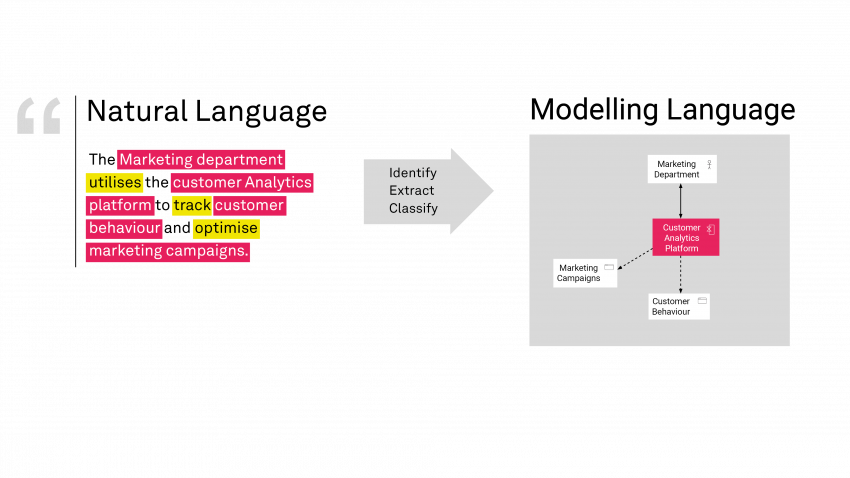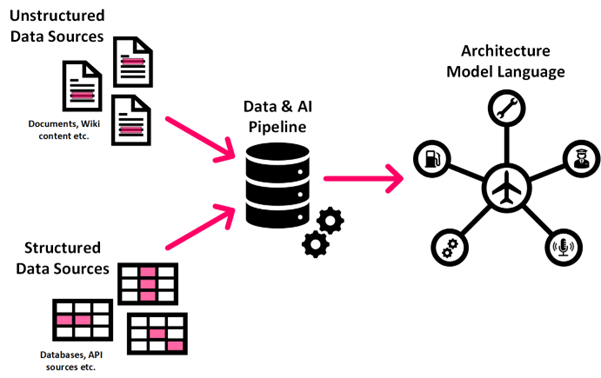
In today’s fast-paced digital landscape, enterprise architecture (EA) plays a critical role in aligning business strategy and capabilities. However, building and maintaining EA models can be a resource-intensive endeavour, requiring significant time and expertise. This is especially true when dealing with vast amounts of unstructured data, such as technical documentation, strategy papers, reports, and requirements specifications. This is where the power of data and AI can come to the rescue, driving automation to help accelerate the enterprise architecture modelling lifecycle.
Traditionally, building EA models involves significant manual effort from architects, who spend a great deal of time reviewing large volumes of documents, gathering inputs from stakeholders, and then mapping out the components of the architecture. This manual process can be time-consuming and difficult to scale efficiently as the complexity of the business and technology landscape grows.
In addition, these models are typically maintained in isolation, with the need to constantly update them as new strategies, projects, or technologies are implemented. With AI and automation, there’s potential to streamline this entire lifecycle, making EA more responsive, adaptable, and efficient.
AI has the potential to revolutionise EA modelling, particularly when it comes to automatically extracting meaningful architecture content from unstructured data sources. Here’s a breakdown of how AI can be leveraged across the enterprise architecture lifecycle. In this example, we assume the ArchiMate model language, but it could equally be applied to other modelling languages and graph-based technologies:
Unstructured data, such as operational documentation, diagrams and reports, often contain valuable insights into the structure and capabilities of the enterprise. AI, specifically Natural Language Processing (NLP), can be used to process these documents and extract key elements relevant to the enterprise architecture. For example:
Identifying Components: AI can recognise architecture components such as business processes, applications, data objects, technologies, and capabilities from textual descriptions. Named Entity Recognition (NER) technology can be used to identify and extract objects such as brand names or company-specific acronyms.
Extracting Relationships: Beyond identifying elements, NLP can also infer relationships between them, such as dependencies, assignments, or flows, which are critical for creating an accurate EA model.
Using NLP techniques, we can automatically parse vast quantities of documents to identify and extract these elements and relationships. A process that would otherwise take architects hours, days or weeks to conduct on a manual basis.
To create a robust architecture model, AI needs to go beyond simple keyword matching. This is where semantic analysis comes in. AI systems can be trained to understand the context in which terms are used, helping them distinguish between different types of architectural elements or relationships.
For instance, in one document, the term “payment” may refer to a business process, while in another, it may refer to a data object or an application component. AI can leverage machine learning models and domain-specific knowledge to infer the correct meaning of these elements and the relationships between them. By training AI models using materials that are specific to the industry sector in which the business operates, this will help improve accuracy of output.
Once AI has extracted the architecture elements and relationships, the next step is to map these to widely adopted EA frameworks like ArchiMate, which provides a structured way to visualise and manage EA models. Here’s how AI can assist:
Mapping Elements to ArchiMate Layers: AI can classify extracted elements into the appropriate ArchiMate layers (e.g., Business, Application, Technology). For example, a "customer onboarding process" would be mapped to the Business Layer, while a "CRM system" would be assigned to the Application Layer. Also, objects like physical components and equipment can be identified and mapped to the Technology Layer.
Generating Models: With AI-driven data transformation techniques, the extracted information can be programmatically converted into ArchiMate-compliant models. This involves not only assigning the elements to layers but also visualising their relationships in a standardised model format. Also, as many enterprise architecture tools offer direct integration options using API technology, this opens the possibility of creating and updating model content directly in the modelling tool repository.
Consistency Checks and Error Detection: AI can also be leveraged to e
AI systems can continuously learn from new data sources, refining their ability to extract and map architecture elements more accurately over time. With the use of feedback loops, AI can improve its performance by learning from corrections made by architects, making the automation process even more reliable.
Moreover, AI can help keep the architecture model updated as new documents are ingested. This continuous integration of data ensures that the EA model is always aligned with the latest business and IT developments.

A significant portion of the EA’s time—often upwards of 60%—is dedicated to research and analysis. The remaining 40% of the time is spent on actual modelling and design work, which involves translating insights and research into actionable architectural plans and models (McKinsey, 2020). With a median Enterprise Architecture salary in the UK of around £90,000 per year, this means approximately £54,000 per Enterprise Architect per year is spent on research and analysis.
AI-driven automation offers several measurable benefits, especially in terms of efficiency of architects’ research and analysis efforts, as well as scalability and future-proofing of models:

Using our experience in this field, we can help you leverage AI and data to transform your enterprise architecture practice in several key ways:
1. Discovery and Assessment
We'll start by thoroughly understanding your current enterprise architecture modelling challenges, your existing data sources and tools, and your goals for improving efficiency and agility. This discovery process will allow us to develop a tailored solution that addresses your unique requirements.
2. Data Ingestion Pipeline
We'll build a robust pipeline to automatically ingest and process the unstructured data sources relevant to your enterprise architecture, such as operational documentation, strategy papers, and technical specifications. This will ensure a seamless flow of information into the AI-powered automation system.
3. Transformation and Modelling
We'll develop the necessary AI-driven transformation processes to extract the relevant architecture elements and relationships from the ingested data, and then map them to the appropriate modelling framework (e.g., ArchiMate) to generate the initial enterprise architecture models.
4. Review and Validation
To ensure the accuracy and reliability of the AI-generated models, we'll establish a review process that involves subject matter experts from your organisation. This will allow us to refine the AI models and incorporate feedback to continuously improve the output.
5. Operationalisation and Integration
Finally, we'll work with you to operationalise the AI-driven enterprise architecture modelling solution, integrating it with your existing tools and processes. This will enable your team to efficiently utilise the automated models and keep them up-to-date on an ongoing basis.
By partnering with Methods Analytics, you can leverage our expertise in AI, data engineering, and architecture to transform your modelling practices, drive greater efficiency, and future-proof your architecture.
AI-powered automation presents a groundbreaking opportunity to enhance enterprise architecture modelling. By leveraging AI and data, organisations can extract meaningful architectural insights from unstructured documents, transform them into EA models, and maintain them with greater speed, accuracy, and efficiency. This not only frees up time for enterprise architects but also ensures that businesses can stay agile, adaptive, and aligned with their strategic goals.
Simon and Giacomo are hosting a workshop on the 25th of November, demonstrating a data-driven approach that streamlines Enterprise Architect model creation and maintenance from unstructured, free-text inputs. Register to attend here

Simon Rae, Technical Architect

Giacomo Lombardi, Senior Data & AI Consultant


